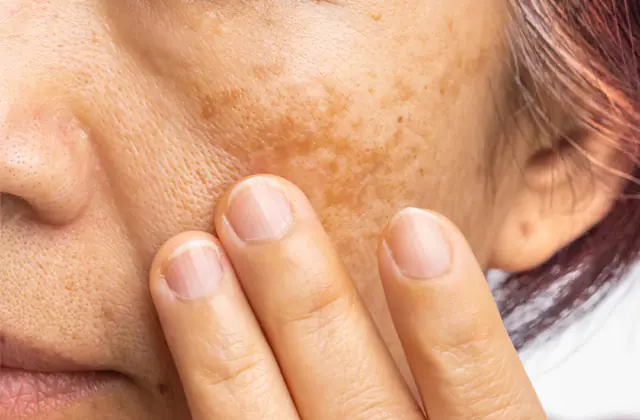
Causes of melasma, main symptoms. How to identify hyperpigmentation and distinguish it from other skin diseases? How to treat melasma with medications, subcutaneous injections, and hardware procedures?
The content of the article:- Reasons for appearance
- Main symptoms
- Diagnostic methods
- Treatment options
- Medical supplies
- Phototherapy
- Facial peeling
- Prevention measures
Melasma is a skin pigmentation disorder that causes spots with clearly defined boundaries to appear on the face and neck. The disease is benign in nature and does not affect the physical condition of a person. Melasma is difficult to cure completely. But regular use of whitening and sunscreen products allows you to achieve stable remission and significantly lighten your facial skin.
Causes of melasma

In the photo there is melasma on a woman's face
Melanin synthesis occurs in epidermal melanocytes. This substance reflects the negative effects of ultraviolet rays, participates in metabolism, neutralizes the effects of toxins, and restores cellular metabolism after poisoning. In addition, the pigment gives tint to the skin, hair, and iris of the eyes.
Melanin deficiency is manifested by frequent sunburn, skin diseases, and surges in blood sugar levels. People with insufficient concentration of pigment are susceptible to developing Parkinson's and Addison's disease.
Excess melanin also has a negative effect on the body. So, spots appear on the skin, which become darker and brighter under the influence of direct sunlight.
Reasons for increased melanin production include:
- genetic predisposition;
- metabolic disorders;
- thyroid diseases;
- ovarian dysfunction;
- long-term use of contraceptives;
- changes in hormonal levels (pregnancy, lactation, menopause);
- liver and gallbladder diseases;
- excess vitamins in the body.
Pigment spots in pregnant women are called chloasma. Gynecologists define them as a subtype of melasma, which occurs when the hormonal levels of expectant mothers change. The disease has the same symptoms, but often disappears on its own after the end of the lactation period.
Another common reason for the appearance of melasma on the face is improper implementation of mesotherapy and deep cleansing of the skin. Even home care with scrubs and gommage creams can damage melanocytes and provoke the growth of pigmentation.
Main symptoms of melasma
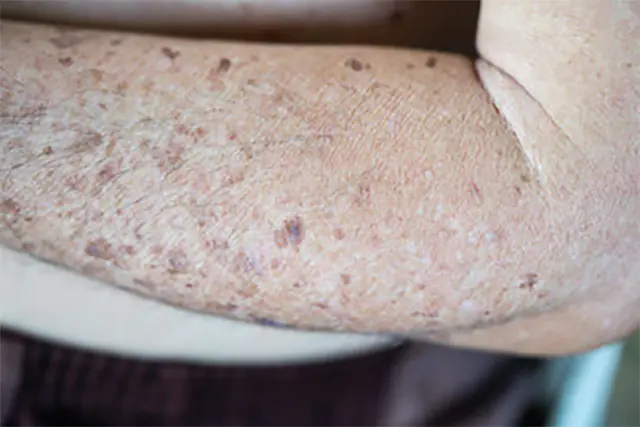
In the photo there is melasma on the hand
Melasma is pigment spots with clearly defined boundaries. Their color ranges from pale brown to dark gray. Areas with hyperpigmentation do not peel, itch, become inflamed, or bleed. But despite the absence of pain symptoms, they bring mental and emotional problems.
It becomes unpleasant for women to look in the mirror and take pictures. They are embarrassed to meet new people or meet old acquaintances.
Melasma is divided into the following subtypes based on location:
- painting (on the cheeks, partly on the nose);
- centrofascial (on the central part of the face);
- mandibular (on the lower part of the cheekbones, upper lip).
According to the nature of the course, melasma is divided into the following types:
- transient (pigmentation disappears after the cessation of exposure to provoking factors);
- persistent (spots lighten during remission and become brighter during exacerbation of hormonal diseases).
In addition, pigmentation increases during the warm season and decreases during the rainy, foggy, and snowy seasons.
According to the depth of damage, melasma is divided into the following types:
- Epidermal. Pigmentation forms in the upper layers of the skin. It is distinguished by a light shade of spots and can be treated with external medications.
- Dermal. Characterized by dark color and blurred boundaries. There is no way to get rid of this type of melasma. Medicines and cosmetics only lighten spots and lengthen the period of remission.
- Mixed. With this complex form of the disease, both dark and light spots appear. Because of this, melasma is difficult to diagnose and distinguish from cutaneous lymphoma, pseudoleukoderma, and non-melanoma cancer.
Without taking therapeutic and preventive measures, melasma grows across the face, becoming darker and brighter. However, the greatest danger comes from improper stain removal. Uncontrolled administration of medicinal injections and excessive application of whitening creams often causes the appearance of inflammatory skin diseases.
Methods for diagnosing melasma
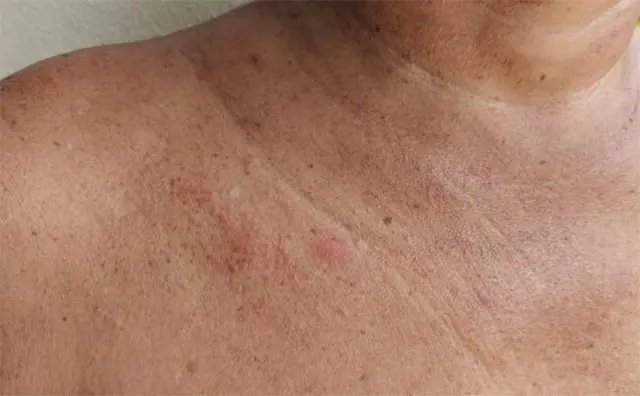
To identify and treat melasma, you need to visit a dermatologist. The doctor determines the disease by external symptoms. But to confirm the diagnosis, he asks the patient about the characteristics of the manifestations, studies his anamnesis, and refers him to diagnostic procedures:
- Wood's lamp examination. The device is a portable lighting device that can be used to highlight any area of the skin. At the initial stage of the study, the doctor turns off the light and puts on safety glasses for himself and the patient. Next, he turns on the lamp so that it illuminates the hyperpigmentation. Healthy skin glows blue, and the problem area glows in other shades. Moreover, each disease manifests itself differently.
- Blood chemistry. Based on the content of hormones, proteins, enzymes, and mineral ions in the blood, a doctor can not only identify melasma, but also understand the cause of its appearance. The liquid is collected using a special syringe with a built-in flask. Next, the biomaterial is sent for testing to the laboratory. The result will be ready in a day. For its accuracy, a number of conditions must be met. Do not eat or drink alcohol 8 hours before the test, do not smoke or be nervous on the day of blood donation. In addition, you need to tell your doctor about all medications that you have taken in the last 3 days.
- Histological examination of the dermis. Analysis of an epithelial particle allows us to examine its composition. Such a study helps differentiate the disease from other skin diseases. It is mainly prescribed for suspected skin cancer. At the preparatory stage, the patient should give up coagulants, alcohol, and not apply cosmetics and care products. At the first stage, the doctor takes a piece of skin using a pinch method. Next, the biomaterial is sealed in a sterile container and taken to the laboratory. The result of the study is recorded and sent to the attending dermatologist.
At a follow-up consultation, the dermatologist tells the patient about the features of his disease and, if necessary, explains the difference between melasma and chloasma. Next, he prescribes medications and procedures to lighten excess skin pigmentation.
Methods for treating melasma on the face
Remember, self-medicating hyperpigmentation can lead to increased melanin production. Only a doctor can tell you how to effectively treat melasma. To do this, he finds out the cause of the disease and prescribes drugs to eliminate it.
Medicines for melasma
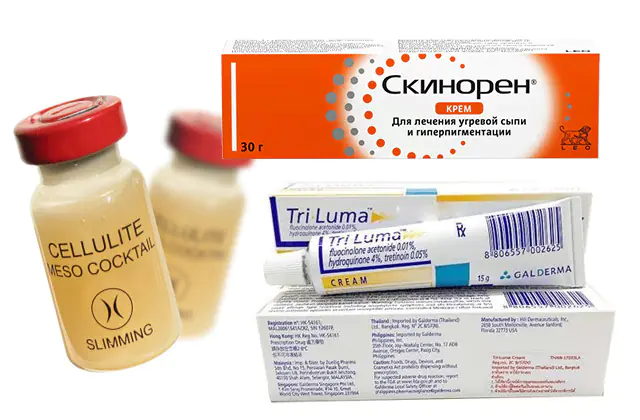
Skin whitening products are available in the form of ointments, creams, and liquid injections. The most effective drugs include:
- Meso cocktails. F-Radiance, Filorga NSTF, Dermaheal and their analogues are available in the form of a liquid for subcutaneous injection. Mesotherapy procedures are performed by a cosmetologist using local anesthesia. Injections are made with a thin needle to a depth of 2-4 mm. The course of complete treatment of melasma on the face is 7-10 sessions.
- Tri-Luma. This melasma cream contains three active ingredients. Hydroquinone blocks melanin synthesis, tretinoin accelerates metabolism in the skin, fluocinolone acetonide extinguishes inflammatory processes. The course of treatment is 3-4 months of daily application. Price - from 6200 rubles in Russia (2915 in Ukraine) for 15 ml.
- Skinoren. The main substance of this cream is azelaic acid. It has a brightening, antibacterial, anti-inflammatory effect. To treat melasma, the product is applied to the skin 2 times a day for 3 months. All this time, a person needs to use sunscreen before going outside (even in rainy weather). Price - 680 rubles in Russia (317 hryvnia in Ukraine) for 30 ml.
Pharmacy treatments for melasma contain rather aggressive active ingredients. Therefore, before treatment, it is necessary to consult a dermatologist and make sure there are no contraindications.
Lightening melasma spots with phototherapy
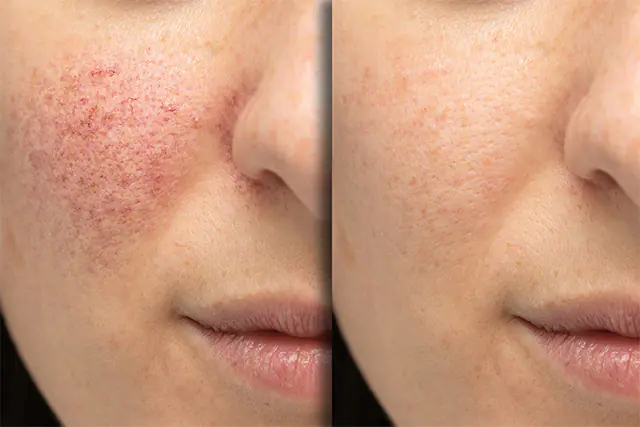
The essence of the method is to destroy melanin by heating with infrared or ultraviolet rays. Contraindications to the procedure are pregnancy, diabetes, and impaired skin integrity.
The patient sits in a chair. The doctor cleans his skin, applies numbing cream, and puts on safety glasses. Next, he acts on the pigment spots with impulses that are emitted by a special device. The procedure lasts 20-30 minutes, during which the patient may feel a slight tingling and burning sensation. At the last stage, the cosmetologist applies a product that removes redness and moisturizes the dermis.
Facial peeling for melasma
To remove dead pigmented cells, doctors recommend undergoing peeling procedures. After completing the course of treatment for melasma, the skin is renewed, scars, scars, and stretch marks are removed.

The photo shows carbon laser skin peeling
There are several types of deep facial cleansing:
- Laser. Dead cells are “burned” using laser beams. Unlike phototherapy, the device is set to broadband mode. That is, one flash can cover a large area of skin. During treatment, the patient sits in a chair and puts on safety glasses. The doctor cleanses his skin and operates the device on it. Next, a stream of cool air is directed onto the face to numb and soothe the dermis.
- Ultrasonic. Dead cells are “torn off” from each other and exfoliated under the influence of vibrations of ultrasonic waves. In addition, a kind of facial massage occurs and collagen production is stimulated. The procedure for melasma is performed with a device with a spatula-shaped attachment. The doctor passes it over the skin at an angle of 45°, after which he moisturizes with mineral water. At the last stage, the cosmetologist applies a soothing cream.
- Chemical. Fruit, salicylic, and lactic acids help cleanse the face of dead cells. During the procedure, skin softening agents are first applied to the patient’s face, followed by the main peeling composition. At the last stage, the face is numbed with analgesics and dry ice. In addition to getting rid of age spots, the method increases the protective functions of the dermis and activates the production of collagen and elastin.
Contraindications to procedures for melasma: pregnancy and lactation, acute phase of chronic diseases, cancer, scratches, wounds, skin rashes.
Melasma Prevention Measures

Always protect your skin from UV rays with sunscreen. Moreover, products labeled “SPF 30” and higher are suitable for the prevention of melasma. Please note that modern cosmetic companies add components to their products to improve the condition of the dermis.
In summer, wear baseball caps whose visors cover your face from ultraviolet rays, wide-brimmed hats, and sunglasses. Visit the beach only in the morning before 9 a.m. and in the evening after 5 p.m. At the same time, do not forget to use sunscreen after each water treatment.
Avoid stressful situations. Remember, mental stress is a common cause of melasma, as hormonal levels change during prolonged stress. Find a suitable way of relaxation for yourself. Meditation, creativity, walking, conversations with old friends help to calm down and find peace of mind.
Contact your dermatologist if dark spots appear on your face and neck. The doctor will determine the disease and its type, and prescribe medications that will help whiten hyperpigmentation. Remember, the sooner you start treatment, the higher the chance of getting rid of melasma forever.
Watch the video to see what melasma is and how to get rid of it:



